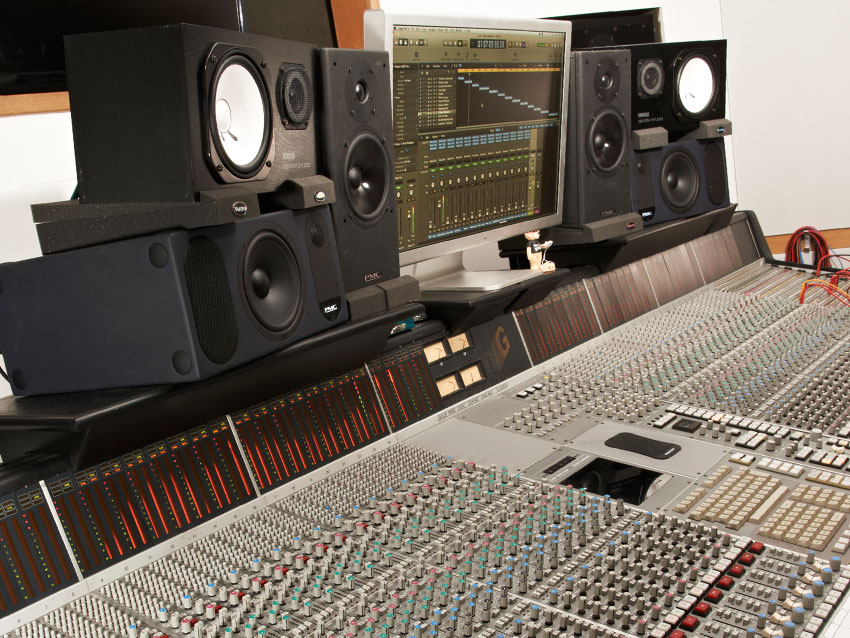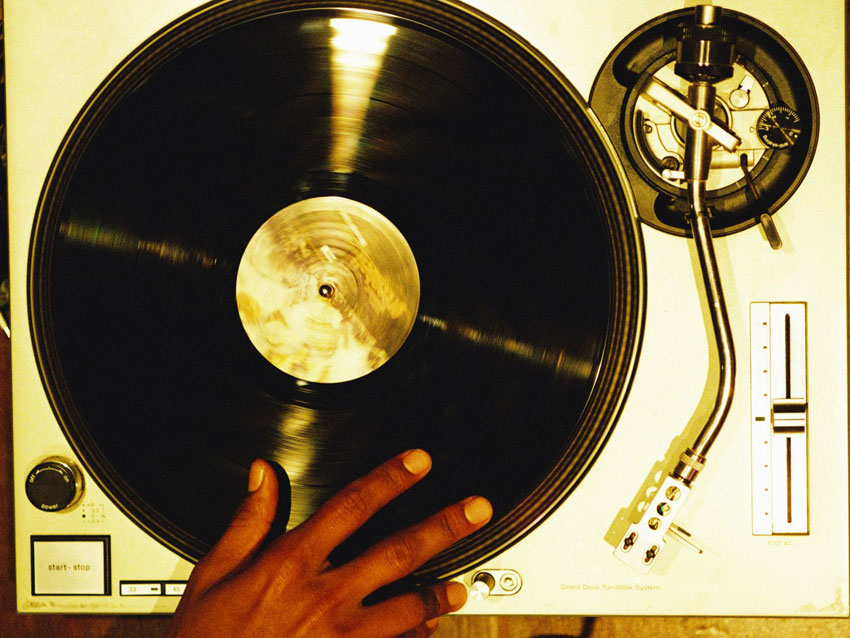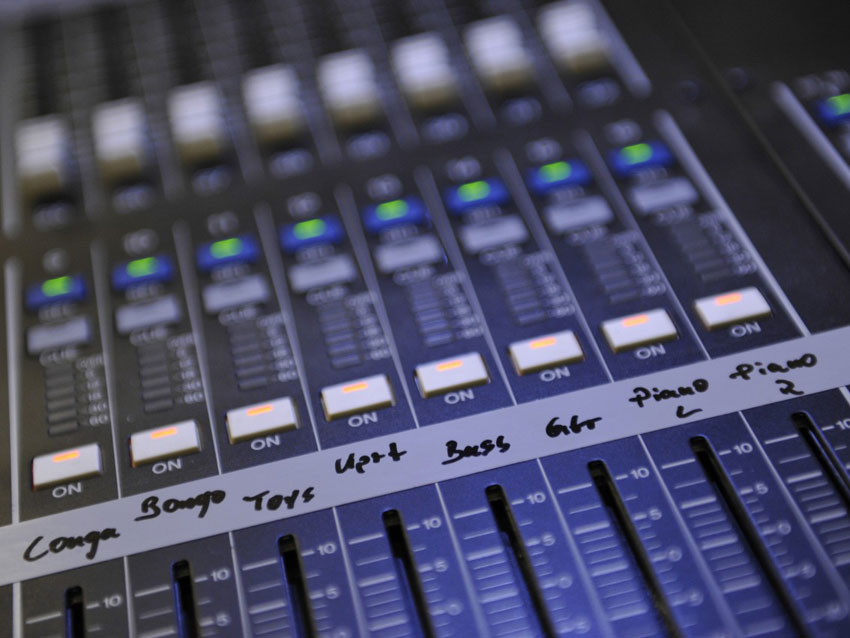26 landmark moments in music production
From Joe Meek to the MPC

Introduction
PRODUCTION EXPO 2013: When Édouard-Léon Scott de Martinville created the phonautograph (the earliest known sound recording device) it was the first in a world-shaking series of leaps and bounds made in the field of recorded music.
In honour of such pioneers let’s take a look back at some of the other seismic and seminal moments in music production that have changed our tiny, insignificant lives for the better.
Let’s salute the trailblazing producers, praise the finest albums, and stare in sheer awe at the pioneering techniques and game-changing machines that have helped bless our ears with sweet music over the course of modern history.
Ladies and gentlemen, we give you 26 landmark moments in music production…

Akai MPC60
Like all great art this iconic sampling and sequencing tool bares the name of the genius that created it. Roger Linn’s fluid scribble sits proudly above the 16 velocity sensitive pads, and has probably been stared at by the most trailblazing producers ever to work in hip-hop.
The MPC60’s rugged build and ‘all-in-one-box’ nature helped quickly establish it as the genre’s ultimate beat making station.
Since its launch in 1988 producers like Marley Marl were quick to unlock its potential for crafting the dopest real time chops and loops from their funky vinyl collections. Which, long with the E-mu SP-1200, would help popularize a style of production that would define hip-hop’s golden age.

Fairlight CMI
When this mother of all samplers was wheeled out in the early ‘80s you’d have had to been Peter Gabriel or Trevor Horn to afford one. They both did, and presumably thought nothing of spending around £75,000 in today’s money on a new bit of kit for the studio.
It was groundbreaking, though. And depending on the series you had, choosing from a light pen interface to the more laborious step-time sequencing of the seminal Page R software, you could sample any sound you wanted and play it back across the keyboard. This sound of sampling would now rule the charts…Today a CMI app costs a mere £6.99 on iTunes.

Solid State Logic SL 4000
The name Solid State Logic is synonymous with the best in high-end mixing consoles.
The company’s first technical innovations can be traced back to 1977’s SL 4000 B model which integrated a studio computer with an in-line audio console, predating the computer music boom.
A much-loved four-band EQ was introduced on 1983’s E-Series. The ‘Black Knob’ EQ hit the spot with modernists craving curve and colour, and was a standout feature on a range that helped define the new clean pop sound that would dominate charts on both sides of the Atlantic.
In fact, SSL claim that more one million selling albums were made on its desks than any other.

I Feel Love
When it came to creating the music for the “future” portion of Donna Summer’s 1977 concept album, I Remember Yesterday, producer Giorgio Moroder would turn to the Moog synthesiser for help.
The track that typified that movement was the standout number, I Feel Love. Moroder’s hypnotic eight-note sequenced bass line arrangement on the Moog Modular synth system would demand that the record became worldwide smash.
Its appeal was instantaneous, but its influence (on pop and then techno) would be felt in club music for many more decades to come. Which is why it’s rightly regarded as one of the most important records in dance music history.

BBC Radiophonic Workshop
The Beeb’s much-celebrated sound effects unit were vastly ahead of their time. Delia Derbyshire and her sonic boffins went boldly into sound, developing rich textures and untapped melody from oscillating electronic noise, laying it down to tape and then arranging it via racks of reel-to-reel machines.
They are perhaps most famous for their work on Dr Who - the sound of the TARDIS time-warping away being a favourite creation of theirs, alongside the show’s other worldly theme music.
Modern electronic pioneers Coldcut doffed their hats to the Workshop by including the Dr Who theme on their legendary Journeys by DJ mix.

Steinberg Cubase
Since the early days of MIDI, and painstakingly tapping away on Pro-16 on a Commodore 64, Steinberg’s music making software has been a top choice for producers the world over.
The German company really started to come into it’s own, however, in the mid-‘80s after computer manufacturers Atari released the ST, complete with an inbuilt MIDI interface.
Coupling an ST with Steinberg’s sequencer created one of the first affordable home studio systems.
A few of the countless notable users over the years have included Photek, Fatboy Slim and Luke Vibert - who started out life by blinking at a Cubase display for far more hours than was considered healthy.

Akai S3000
The reason for the phenomenal success of Akai’s S-series range of samplers can be boiled down to its straight up sampling power.
Having 44.1kHz 16-bit stereo sampling capabilities to play with was a hoot. Add to that up to 32MB of RAM, along with advanced editing options that included looping and time stretching, and you had quite a machine in that unassuming grey box.
The S3000 (pictured middle) was the most versatile of the bunch, and its rugged build, synth-like filters and sizable display screen made it an instant hit.
It’s a true legend, and thanks to the easy to navigate interface it became one of the most popular samplers of all time.

Lee 'Scratch' Perry
Without Lee ‘Scratch’ Perry there would be no modern bass culture.
The eccentric Jamaican producer’s pioneering experiments with echo and tape delays, and his studies in low-end theory, helped create dub - The patient zero of all strains of dance music.
He might have been rocking some busted kit in those days, but his precision behind the boards, and his vision for the music, meant his Midas touch turned the bass-heavy results into solid gold.
Fans of PiL or The Orb will recognise the connection. And all junglist crew and dubstep heads today are skanking to a sound that began life in his Black Ark studio.

Timeless
Jungle supremo Goldie’s 1995 debut album is a masterpiece of the genre. It blew everything away with its complexity, groove, intellect and emotion.
It signalled a new level of maturity for the genre, and opened the door for the likes of Roni Size to explore the musical potential of drum ‘n’ bass.
An unsung hero of the project is engineer Rob Playford. It might have been the gold-toothed Wulfrunian’s vision, ambitious direction and samples, but Playford handled the next-level programming and production.
Between the two of them they turned an underground club phenomenon into the sound of the year, and the most unique UK movement since punk.

My Life In The Bush of Ghosts
Brian Eno and David Byrne were way ahead of the sampling curve back in 1981 when they put this pioneering work together.
Lead vocals from pop and rock singers (and even the sound of an exorcist) were flown in live from tapes - pre-sampler - And they all had to be had to be cleared as well, pre-dating courtroom capers acts like Biz Markie and the Beasties would face years later.
Besides these ‘found sounds’ they twisted melons further by making drum kits out of cardboard and frying pans. If they were ever regarded as 'pop' artists then, the term ‘avant-garde’ would be the new description on reviewers’ lips.

Roland 808
These days you can harness the power of the TR-808 Rhythm Composer on your snazzy smart phone, but back when Roland unleashed this beauty onto the world in 1980 who knew its impact would resonate for decades to come?
Its appeal is down to the boomastic bass kicks, crispy snares and iconic cowbell it had on offer.
Electronic legends 808 State took their name from this powerful machine, and much of their music was made up from its trademark analogue synthesis.
The 808 was part of an impressive stable, including the 909 and 303, which would go on to change the pound of hard-hitting music like hip-hop, house and techno for generations to come.

Phil Spector
Musical historians are best not to dwell on Spector’s more recent infamy, and instead concentrate on that prolific period in the sixties and seventies when his fabled ‘Wall of Sound’ production style lit up the pop charts like no one before.
His genius lay in the dense, multi-layered arrangements he turned in for everyone from The Righteous Brothers to The Ronettes.
On any given day his tiny Gold Star studio in Hollywood would swell to fit the vast number of session musicians crammed in to create the enormous mono sound he needed to blast over the radio.
Abba and Bruce Springsteen’s biggest sounding work bares the master’s overarching influence.

Scratching
John Cage used turntables in compositions in late ‘30s, but he was just happy to let them randomly play. The Bronx DJs of the late ‘70s, however, thought it was far more fun to play them.
Turntablists like Grand Wizzard Theodore started the fashion for scratching, and a new style of sound manipulating was born.
Giant leaps occurred in underground DJ comps like the DMCs, while the mainstream got the itch to scratch through DJ-led records like The Adventures of Grandmaster Flash on the Wheels of Steel and Herbie Hancock's Rockit.
Today you can study turntablism in schools - a revolution, indeed.

Pet Sounds
By trying to catch up with Phil Spector, and keep one step ahead of the Beatles, Beach Boy Brian Wilson ended up creating one of pop’s bona fide masterpieces.
Richly symphonic, and featuring exotic instruments and non-instruments, it would be the Beach Boys finest album, and one of the best of the sixties.
The chord progressions are a thing of beauty, the melodies heart swelling, but it’s the vocal arrangements that border on the sublime.
Not as popular as other Beach Boys albums, but the one other producers never tire of waxing lyrical about, which suggests something…

Tape splicing
After Bing Crosby got Ampex to develop reel-to-reel tape machines, they quickly became the industry standard recording format. This new technology allowed you to edit sessions armed with only a razor blade.
Masters of the splice included Columbia Records producer, Teo Macero. His tape editing for Miles Davis’ Kind of Blue and Bitches Brew LPs would transform already inspired takes into complex new juxtapositions, resulting in far more cohesive albums than the visionary Jazz trumpeter could have ever imagined.
Brain Eno is just one of the other greats who praises Macero's editing techniques. In fact, all producers who chop and edit today owe him credit.

Selected Ambient Works 85-92
Although only a bedroom producer, and using the barest of equipment, Aphex Twin would go onto change the face of British Techno.
This compilation of ambient instrumentals, peppered with samples from TV and film (including Willy Wonka and RoboCop), might have been crudely made - He mastered off cassettes in some cases - But it’s as vital as anything to come out of Detroit or Chicago.
His approach to computer music was unparalleled, and the pitch shifted tones and complex glitchy jerks he wrung from his limited kit would define the new wave, and turn him into an electronic music God.

3 Feet High and Rising
You could pick one of a dozen albums that featured the beat making prowess of super producer Prince Paul, but De La Soul’s Day-Glo debut remains a high-water mark in hip-hop sampling.
‘Eclectic’ doesn’t do the source material justice. Paul’s Akai S900 sampler must have fizzed and popped as he filled it with snatches of wax from artists as diverse as Hall & Oates, The Monkees, Liberace and Johnny Cash.
He took Afrika Bambaataa's credence that anything could be hip-hop and ran away with it, laughing like a loon. You can feel its legacy in modern sample slayers like The Avalanches, who also employ this magpie approach.

Kraftwerk
This seminal electronic quartet forged a futuristic sound and identity that paved the way for countless acts and genres to follow.
Their striking originality came from their vision of a post-war Germany built on technology and an unwavering forward-marching beat.
To soundtrack this ideal they built their own hand-made instruments, and formulated a blueprint for ‘robot-pop’ - a pulsing, rigid, ever-evolving form of musical hypnotics made from entirely electronic machines.
Their impact on the music that followed was gigantic. All forms of EDM can be traced back to Florian Schneider and the rest of his tidy looking ensemble of cycling enthusiasts.

Nile Rodgers
The intoxicating rhythms this saucy funkateer effortlessly whipped up for himself, or for collaborators like Diana Ross, David Bowie, Duran Duran and Madonna, have caused more dance floor carnage than any other living soul.
With his band Chic he ruled disco (and the discos). And after The Sugarhill Gang nicked a chunk of his Good Times, his name was added to the hip-hop history books as well.
Crucially, he’s still relevant - his groovy Strat work, and general presence, was the coolest thing about this year’s biggest single, Get Lucky by Daft Punk. Nile Rodgers - We salute you.

The Dark Side of the Moon
A proper ‘headphone album’ through and through, Pink Floyd’s prog-rock opus stands out in their weighty canon of because of its sonic majesty.
For the bands’ eighth long player Abbey Road’s high-tech spec was plundered, and experiments with the latest analogue synthesizers were undertaken. Multi-tracking and tape looping possibilities were also attempted with a similarly unwavering confidence, and garnered mesmerising results.
Production legend Alan Parsons was the studio’s ‘balance engineer’ and would beaver away on the sound when the band had gone home.
The results were far more complex than the bold and minimalist cover art initially led to you believe.

Multi-tracking
Initial processes for dividing tape up, recording onto it separately, and then playing it all back concurrently first cropped up in 1950s Germany.
These two-track machines caught the eye of Les Paul, who then had a successful crack at a three-track version. Manufactures Ampex saw the potential, bought the machine and developed it, which really opened up a brave new world of recording and bouncing for forward-thinking producers.
Artists could now record multiple takes of their work, and be punched in and out until the magic happened.
Motown and Abbey Road masterpieces benefited from these advances, while modern bands today return to the machines for their unbeatable warmth.

The Neptunes
The mark of a great producer is their ability to define the sound of an era. The omnipresent Neptunes production outfit of Pharrell Williams and Chad Hugo did just that.
Their slick beats were as regular a fixture of the singles charts of the early ‘00s as the numbers next to the songs themselves. An oft-cited 2003 ‘survey’ suggested the duo produced almost 20% of songs played on British radio at the time, and added that you could double that for the US.
Regardless, their trademark synth magic and off-kilter percussion arrangements made career-best hits for the likes of Jay-Z, Kelis, Britney Spears, Busta Rhymes, Snoop Dogg and Justin Timberlake.

Stereophonic sound
When ‘stereo demonstration’ records hit the market in the late ‘50s listeners could now be taken on a “stereo fantasia” as sound effects and Dixieland jazz swirled around their front rooms.
Mono now seemed hideously out-dated as stereo brought the home listening experience closer to that of the concert hall. “Ooh, just over there to the right - A timpani drum!”
Producers relished the new potential to get spacious with their music as well, and began panning like crazy as the FM radio boom took their music into more and more homes and cars.
The birth of stereo created a new standard for high fidelity and a new demand for higher quality from the customer.

Quincy Jones
Quincy Jones is the greatest producer of all time. His ‘tale of the tape’ takes in a record number of Grammy nominations at 79, 33 film soundtracks, and the biggest-selling album of all time - Thriller at 110 million sales.
He’s a master of musical hybrids, fusing pop, Brazilian, disco, soul, hip-hop, jazz, classical and African music effortlessly together in the 60-odd years he’s been behind the boards.
Who else could bring together artists like Ella Fitzgerald, Miles Davis, Chaka Khan, Ice-T and Big Daddy Kane for 1989’s groundbreaking album Back On The Block? Probably the man who brought together the super group USA for Africa, for 20 million selling charity single, We Are The World, that’s who.

MIDI
The Musical Instrument Digital Interface is 30 this year. This technological breakthrough, which allows musical instruments, computers, and other related devices to communicate with one another, was debuted to the public at NAMM ’83.
Synth god Dave Smith gleefully paraded the MIDI connection between his Prophet 600 and a Roland JP-6 that year, and music making changed forever.
It would grant as little as one performer the power to operate vast banks of synths and samplers. No formal understanding of musical notion was required, either.
The sound of the ‘80s is thanks to people like Dave Smith, who picked up a Technical Grammy last year for his work in developing MIDI as we know it today.

Joe Meek
1960s pop was the preserve of stuffy men in grey suits, and made by stuffier men in lab coats. Meek changed that when he set up his RGM label and recording studio above a shop on Holloway Road, London.
His flat hummed with makeshift machines and sonic innovations of his own devising. Besides leaping up and down on the floorboards to beef up kick drums, Meek dreamt multiple over-dubbing, close mic placement, compression, echo effects and reverb techniques before anybody else.
His approach was out of this world. Fitting then that his first smash hit - Telstar by The Tornados - was a tribute to new space age technology.
Words by Roy Spencer